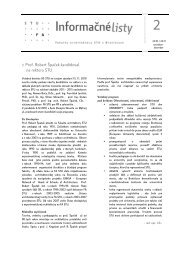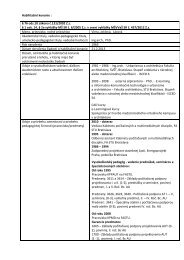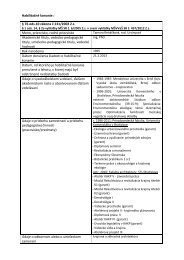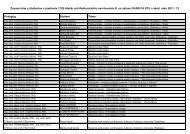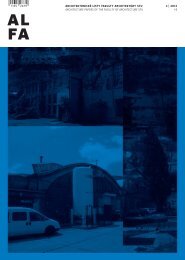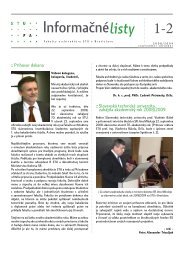ALFA 3-4/2005 - Fakulta architektúry STU
ALFA 3-4/2005 - Fakulta architektúry STU
ALFA 3-4/2005 - Fakulta architektúry STU
Create successful ePaper yourself
Turn your PDF publications into a flip-book with our unique Google optimized e-Paper software.
Ročník 9<br />
3-4 / <strong>2005</strong> ARCHITEKTONICKÉ LISTY FA <strong>STU</strong><br />
Time saved walking may be translated into more time spent on<br />
patient-care activities and interaction with family members. Fewer<br />
trips are made to patient rooms in radial units as nurses are able<br />
to better supervise patients visually from the nursing station,<br />
though the average time spent with patients is the same in radial<br />
as well as single corridor designs. Nursing staff in the radial unit<br />
walked significantly less than staff in the rectangular unit<br />
(4.7 steps per minute versus 7.9 steps per minute). Furthermore,<br />
radial designs might provide less flexibility in managing patient<br />
loads. That’s why if we decrease in the percentage of time spent<br />
walking by staff in radial units, we will increase in the percentage<br />
of time spent in patient-care activities. Also, more of the staff<br />
surveyed preferred to work in the radial units.<br />
We can also reduce staff walking with decentralized nurses’<br />
stations and increased patient-care time, especially when supplies<br />
are also decentralized and placed near the nurses’ station. But for<br />
some technical and treatment departments (like surgical<br />
departments, diagnostic and service departments, X-ray<br />
departments) are required to be centralized however could double<br />
staff walking, because of technical support and specific layout<br />
requirements, where is necessary to provide smoothly processing<br />
flow. Workplace design that reflects the physical setting, such as<br />
redesign of a hospital’s layout, has been shown to improve<br />
workflow and reduce waiting times, as well as increase patient<br />
satisfaction with the service.<br />
Poor ergonomic design of patient beds and nurses’ stations leads<br />
to back stress, fatigue and other injuries among nursing staff.<br />
Thus, reducing staff stress by ergonomic interventions, as well as<br />
careful consideration of other issues such as air quality, noise, and<br />
light, can have significant impact on staff health. In addition, health<br />
and safety of staff members is also an important goal for<br />
the healthcare organization.<br />
Reduce patient falls<br />
This is an area of great importance because patients who fall incur<br />
physical injuries and psychological stress, with the result of<br />
greater lengths of stay in the hospital. According to research<br />
(Ulrich&Zimring 2003) the great majority of falls occur when<br />
disabled patients get out of bed or move around unassisted.<br />
The ‘geography’ of falls indicates that most occur at the edge of<br />
patient beds to a lesser extent falls in front of chairs and at<br />
doorways to toilets.<br />
Doorways falls, can happen when the door is too narrow to enable<br />
staff or family to assist the patient through. The design solution is<br />
to provide wide doorways that make it possible for staff or family<br />
to stay at the patient’s side when going through a door, and not be<br />
pruned off by a narrow gap.<br />
Other design features that reduce falls include handrails along<br />
communication spaces and appropriate flooring. The most critical<br />
- 38 -<br />
part of an effective architectural strategy for preventing falls is<br />
designing patient rooms and nurses’ stations to make it much<br />
easier for staff and family members to be present and assist<br />
patients when they get up from bed or move around the room. In<br />
this regard, decentralised nursing stations compared to<br />
centralised stations place staff closer to patient rooms and shorten<br />
response times to patient calls. Also, well-designed decentralized<br />
nursing stations enable staff to keep direct line-of-sight<br />
surveillance of those patients at high risk from falling. Further,<br />
providing large single-bed patient rooms with comfortable furniture<br />
is very important for supporting the ongoing presence of family<br />
who are there to assist the patient and prevent falls. Changing<br />
from centralised nursing stations and multi-bed rooms to<br />
decentralised staff workstations and single-bed family-centred<br />
rooms reduced falls by two-thirds (lecture of Ulrich on NHS<br />
symposium, 2003).<br />
Reduce Depression<br />
Using light as an intervention to reduce depression in clinically<br />
depressed as well as not depressed patients is a relatively<br />
inexpensive intervention that has been shown to bring consistently<br />
positive results. Bright light (both natural and artificial) can<br />
improve health outcomes such as depression, agitation, sleep,<br />
circadian rest-activity rhythms, as well as decrease length of stay<br />
of patients and persons with seasonal affective disorders (Brain<br />
Lawson, 1997).<br />
There is also strong evidence that exposure to morning light is<br />
more effective than exposure to evening light in reducing<br />
depression. If we compare the effect of morning and evening light<br />
on patients with winter depression found that morning light was<br />
twice as effective as evening light in treating (Lewy et al., 1998).<br />
Café as a part of the hospital.



